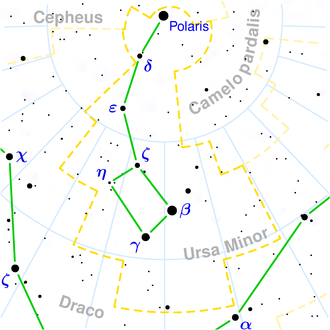Pherkad
|
Star Pherkad (γ Ursae Minoris) |
|||||||||||||||||
|---|---|---|---|---|---|---|---|---|---|---|---|---|---|---|---|---|---|
| AladinLite | |||||||||||||||||
|
Observation dates equinox : J2000.0 , epoch : J2000.0 |
|||||||||||||||||
| Constellation | Little Bear | ||||||||||||||||
| Right ascension | 15 h 20 m 43.72 s | ||||||||||||||||
| declination | + 71 ° 50 ′ 2.5 ″ | ||||||||||||||||
| Apparent brightness | 3 likes | ||||||||||||||||
| Typing | |||||||||||||||||
| B − V color index | +0.05 | ||||||||||||||||
| U − B color index | +0.12 | ||||||||||||||||
| R − I index | +0.06 | ||||||||||||||||
| Spectral class | A3 II-III | ||||||||||||||||
| Variable star type | Delta Scuti star | ||||||||||||||||
| Astrometry | |||||||||||||||||
| Radial velocity | (−3.9 ± 0.6) km / s | ||||||||||||||||
| parallax | (6.70 ± 0.11) mas | ||||||||||||||||
| distance | (486.8 ± 8.0) Lj (149.3 ± 2.5) pc |
||||||||||||||||
| Visual absolute brightness M vis | −2.87 mag | ||||||||||||||||
| Proper movement | |||||||||||||||||
| Rec. Share: | (−17.73 ± 0.13) mas / a | ||||||||||||||||
| Dec. portion: | (17.90 ± 0.11) mas / a | ||||||||||||||||
| Physical Properties | |||||||||||||||||
| Dimensions | 5 M ☉ | ||||||||||||||||
| radius | 15 R ☉ | ||||||||||||||||
| Luminosity |
1100 L ☉ |
||||||||||||||||
| Effective temperature | 8600 K | ||||||||||||||||
|
Other names and catalog entries |
|||||||||||||||||
|
|||||||||||||||||
| annotation | |||||||||||||||||
|
|||||||||||||||||
Pherkad , also Pherkab or Gamma Ursae Minoris (γ UMi), is the name of the third brightest star in the constellation Little Bear . The Arabic nameفرقد, DMG farqad is derived from Arabicأخفى الفرقدين / aḫfā l-farqadain ab and means "the darker of the two calves" (with the lighter calf the star Kochab was meant).
Pherkad, together with Kochab, forms the end of the box of the constellation “Little Dipper”, which the Little Bear is also often seen as. It has an apparent magnitude of 3.03 mag and is therefore easy to see with the naked eye.
Pherkad is a white, bright giant star and belongs to the spectral class A3. Its distance from the Sun is about 480 light years according to the Hipparcos database .
